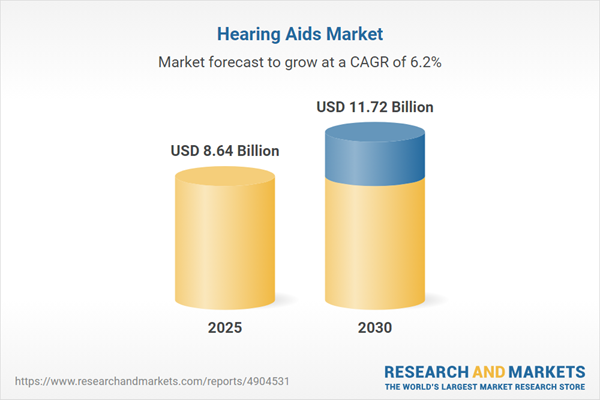Speak directly to the analyst to clarify any post sales queries you may have.
The global hearing aids market is undergoing significant transformation amid rapid technological innovation, evolving regulatory frameworks, and shifting consumer preferences. Senior decision-makers must navigate emerging complexities to sustain growth and competitive differentiation within this dynamic landscape.
Market Snapshot: Hearing Aids Market Performance and Growth Outlook
The hearing aids market grew from USD 8.15 billion in 2024 to USD 8.64 billion in 2025, with expectations to maintain robust expansion at a CAGR of 6.23% to reach USD 11.72 billion by 2030. Market growth is fueled by the interplay of an aging global population, advances in digital hearing technologies, and the increased availability of over-the-counter (OTC) solutions. Progressive regulatory reforms and the introduction of streamlined reimbursement models further support market expansion, influencing regional adoption rates and competitive dynamics.
Scope & Segmentation
- Device Type: Behind-the-ear, canal, in-the-ear, and receiver-in-the-ear hearing aids serve a range of patient needs from ease of handling to discreet wear.
- Type: Over-the-counter hearing aids and prescribed hearing aids provide varying levels of accessibility and clinical oversight.
- Technology Type: Analog and digital architectures underpin performance, with digital variants offering enhanced customization and connectivity.
- Patient Age Group: Segments include adult, geriatric, and pediatric populations, each with distinct design and durability requirements.
- Connectivity Options: Wired and wireless connectivity support integration with media devices and enable remote programming.
- Distribution Channel: Offline channels (pharmacy outlets, specialty stores) and online channels (brand-owned websites, e-commerce platforms) enhance reach and user engagement.
- Regions Covered: Americas (North America, Latin America), Europe, Middle East & Africa, Asia-Pacific. Established markets leverage advanced teleaudiology and reimbursement systems, while developing economies focus on increasing awareness and access.
- Companies Profiled: Industry leaders and innovators such as Amplifon SpA, Cochlear Limited, Demant A/S, Sonova Holding AG, and emerging brands are analyzed for strategy and market contribution.
Key Takeaways for Decision-Makers
- Digitalization drives competitive differentiation, with remote audiological services and AI-enabled features playing a central role in user satisfaction.
- Shifting regulatory landscapes encourage new OTC models, broadening market entry but requiring careful attention to compliance and patient safety.
- Technology convergence—from miniaturized components to cloud-based analytics—improves device discretion, real-time performance monitoring, and user engagement.
- Consumer-driven trends prioritize comfort, personalization, and expanded connectivity, influencing form factor innovations and bundled service models.
- Regional market strategies must align with local reimbursement policies, patient demographics, and clinical ecosystem maturity to secure sustainable growth.
Tariff Impact: Adjusting to United States Regulatory Change
Recent United States tariffs on imported components and finished devices have added complexity to supply chain management. Leading manufacturers are responding by diversifying sourcing, considering nearshoring, and negotiating supplier terms to reduce cost volatility. Smaller brands face increased pressure as they adapt to fluctuating input costs, further emphasizing the importance of supply chain resilience and operational flexibility.
Methodology & Data Sources
This report applies a rigorous research process combining primary interviews with industry experts, secondary review of regulatory filings and market literature, and triangulation of internal and external quantitative datasets. Qualitative insights were validated via peer review and expert panel evaluation to ensure objectivity and actionable outcomes.
Why This Report Matters
- Provides a strategic overview that empowers C-suite leaders to identify growth opportunities and respond effectively to new regulatory or technological developments.
- Delivers granular market segmentation and competitor insight to inform R&D investments, market access strategies, and product innovation pipelines.
- Supports operational planning by clarifying regional dynamics, distribution trends, and emerging risks tied to policy or supply chain disruptions.
Conclusion
The hearing aids market is being reshaped by advancements in digital technology, evolving access pathways, and tailored solutions for diverse user groups. Stakeholders that prioritize innovation, adapt to regulatory change, and leverage robust operational frameworks will secure competitive advantage in an evolving global marketplace.
Additional Product Information:
- Purchase of this report includes 1 year online access with quarterly updates.
- This report can be updated on request. Please contact our Customer Experience team using the Ask a Question widget on our website.
Table of Contents
3. Executive Summary
4. Market Overview
7. Cumulative Impact of Artificial Intelligence 2025
Companies Mentioned
The companies profiled in this Hearing Aids market report include:- Amplifon SpA
- Arphi Electronics Private Limited
- Audicus, Inc.
- audifon GmbH & Co. KG by KIND Group
- Audina Hearing Instruments, Inc.
- Aurica LLC
- Austar Hearing Science and Technology (Xiamen) Co., Ltd. by Merry Group
- Cochlear Limited
- Demant A/S
- Earlens Corporation
- GN Store Nord A/S
- Great Earsmate Technology Group Ltd.
- Horentek S.r.l.
- JINGHAO MEDICAL
- LUCID HEARING HOLDING COMPANY, LLC
- LXE Hearing
- MDHearingAid, Inc.
- Medtronic PLC
- MED−EL Elektromedizinische Geräte Gesellschaft m.b.H.
- Nano Hearing Aids
- Rion Co., Ltd.
- SeboTek Hearing Systems, LLC
- Sonova Holding AG
- Sony Corporation
- Starkey Hearing Technologies
- WS Audiology A/S
- Xiamen NewSound Technology Co.,Ltd
Table Information
| Report Attribute | Details |
|---|---|
| No. of Pages | 183 |
| Published | November 2025 |
| Forecast Period | 2025 - 2030 |
| Estimated Market Value ( USD | $ 8.64 Billion |
| Forecasted Market Value ( USD | $ 11.72 Billion |
| Compound Annual Growth Rate | 6.2% |
| Regions Covered | Global |
| No. of Companies Mentioned | 28 |









